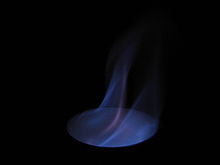- Chemical derivatives of ethanol
-
Ethanol is a common chemical with widespread industrial use. The following are some common derivatives of ethanol.
Contents
Acid-base chemistry
Ethanol's hydroxyl proton is weakly acidic, having a pKa of only 15.9, compared to water's 15.7[1] (Ka of ethanol is a measure of
![\scriptstyle \frac {[C_2H_5O^-][H^+]} {[C_2H_5OH]}](5/d95ea137f082edf55769b4bbcd06c7f5.png) . Note that Ka of water is derived by dividing water's dissociation constant,
. Note that Ka of water is derived by dividing water's dissociation constant, ![\scriptstyle [H^+][OH^-] = 1.0 \times 10^{-14}](d/c3d893531b5e26c0eb74397bf55094f3.png) moles²/liter, by its molar density of 55.5 moles/liter). Ethanol can be quantitatively converted to its conjugate base, the ethoxide ion (CH3CH2O−), by reaction with an alkali metal such as sodium. This reaction evolves hydrogen gas:
moles²/liter, by its molar density of 55.5 moles/liter). Ethanol can be quantitatively converted to its conjugate base, the ethoxide ion (CH3CH2O−), by reaction with an alkali metal such as sodium. This reaction evolves hydrogen gas:Nucleophilic substitution
In aprotic solvents, ethanol reacts with hydrogen halides to produce ethyl halides such as ethyl chloride and ethyl bromide via nucleophilic substitution:
Ethyl halides can also be produced by reacting ethanol by more specialized halogenating agents, such as thionyl chloride for preparing ethyl chloride, or phosphorus tribromide for preparing ethyl bromide.
Esterification
Under acid-catalysed conditions, ethanol reacts with carboxylic acids to produce ethyl esters and water:
- RCOOH + HOCH2CH3 → RCOOCH2CH3 + H2O
The reverse reaction, hydrolysis of the resulting ester back to ethanol and the carboxylic acid, limits the extent of reaction, and high yields are unusual unless water can be removed from the reaction mixture as it forms. Esterification can also be carried out using more a reactive derivative of the carboxylic acid, such as an acyl chloride or acid anhydride. A very common ester of ethanol is ethyl acetate, found in nailpolish remover.
Ethanol can also form esters with inorganic acids. Diethyl sulfate and triethyl phosphate, prepared by reacting ethanol with sulfuric and phosphoric acid, respectively, are both useful ethylating agents in organic synthesis. Ethyl nitrite, prepared from the reaction of ethanol with sodium nitrite and sulfuric acid, was formerly a widely-used diuretic.[citation needed]
Dehydration
Strong acids, such as sulfuric acid, can catalyse ethanol's dehydration to form either diethyl ether or ethylene:
- 2 CH3CH2OH → CH3CH2OCH2CH3 + H2O
Although sulfuric acid catalyses this reaction, the acid is diluted by the water that is formed, which makes the reaction inefficient. Which product, diethyl ether or ethylene, predominates depends on the precise reaction conditions.
Oxidation
Ethanol can be oxidized to acetaldehyde, and further oxidized to acetic acid. In the human body, these oxidation reactions are catalysed by enzymes. In the laboratory, aqueous solutions of strong oxidizing agents, such as chromic acid or potassium permanganate, oxidize ethanol to acetic acid, and it is difficult to stop the reaction at acetaldehyde at high yield. Ethanol can be oxidized to acetaldehyde, without overoxidation to acetic acid, by reacting it with pyridinium chromic chloride.
Combustion
Combustion of ethanol forms carbon dioxide and water:
- C2H5OH + 3 O2 → 2 CO2 + 3 H2O
Ethyl esters
In the presence of an acid catalyst (typically sulfuric acid) ethanol reacts with carboxylic acids to produce ethyl esters:
The two largest-volume ethyl esters are ethyl acrylate (from ethanol and acrylic acid) and ethyl acetate (from ethanol and acetic acid). Ethyl acrylate is a monomer used to prepare acrylate polymers for use in coatings and adhesives. Ethyl acetate is a common solvent used in paints, coatings, and in the pharmaceutical industry; its most familiar application in the household is as a solvent for nail polish. A variety of other ethyl esters are used in much smaller volumes as artificial fruit flavorings.
Vinegar
Vinegar is a dilute solution of acetic acid prepared by the action of Acetobacter bacteria on ethanol solutions. Although traditionally prepared from alcoholic beverages including wine, apple cider, and unhopped beer, vinegar can also be made from solutions of industrial ethanol. Vinegar made from distilled ethanol is called "distilled vinegar", and is commonly used in food pickling and as a condiment.
Ethylamines
When heated to 150–220 °C over a silica- or alumina-supported nickel catalyst, ethanol and ammonia react to produce ethylamine. Further reaction leads to diethylamine and triethylamine:
- CH3CH2OH + NH3 → CH3CH2NH2 + H2O
- CH3CH2OH + CH3CH2NH2 → (CH3CH2)2NH + H2O
- CH3CH2OH + (CH3CH2)2NH → (CH3CH2)3N + H2O
The ethylamines find use in the synthesis of pharmaceuticals, agricultural chemicals, and surfactants.
Other chemicals
Ethanol in the past has been used commercially to synthesize dozens of other high-volume chemical commodities. At the present, it has been supplanted in many applications by less costly petrochemical feedstocks. However, in markets with abundant agricultural products, but a less developed petrochemical infrastructure, such as the People's Republic of China, Pakistan, India, and Brazil, ethanol can be used to produce chemicals that would be produced from petroleum in the West, including ethylene and butadiene.
References
- ^ Andrew Streitwieser and Clayton H. Heathcock: Introduction to Organic Chemistry, Macmillan 1976, p 215
Categories:- Alcohols
Wikimedia Foundation. 2010.

